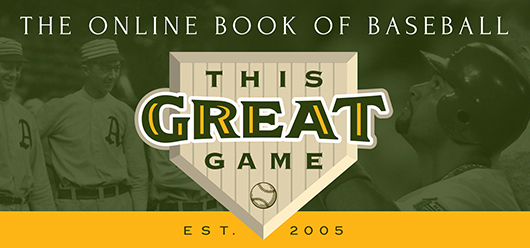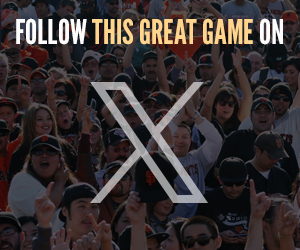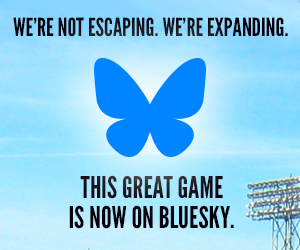THE TEAMS
The Reds’ 10 Greatest Hitters
 Frank Robinson (1956-65)
Frank Robinson (1956-65)
Born in Texas but raised in Oakland, the man who would blast out 586 career home runs was initially mistaken as being a surly, withdrawn figure in the Cincinnati clubhouse—but in fact, it was the end result of the shellshock he absorbed playing minor league ball below the Mason-Dixon line, where he ran into racial prejudice head-on. But Robinson quickly made friends at the big-league level when he punched out 38 home runs in his rookie year of 1956—tying a major league record that would stand until Mark McGwire broke it 31 years later.
Three times while with the Reds, Robinson hit over .300 with at least 30 homers and 100 runs batted in; he won the National League MVP award in 1961 with a .323-37-124 performance that helped give the Reds their first pennant in 21 years, and he put up even more impressive numbers the next year—batting .342 with 39 homers, 136 RBIs and league-best figures in 134 runs and 51 doubles—yet finished fourth in that year’s MVP tally. Relative lean times struck Robinson over the next few years, but despite a bounce-back campaign in 1965, the Reds were unconvinced of his long-term prospects; he was traded to the Baltimore Orioles as Cincinnati owner Bill DeWitt famously declared that the move was proper because Robinson had become an “old 30.” DeWitt’s words would quickly come back to haunt him; Robinson went on to win the hitter’s triple crown, the AL MVP and the World Series for the Orioles in 1966. Still, Robinson was popular enough in absentia that he would eventually see his uniform number 20 retired by the Reds in 1998.
 Joe Morgan (1972-79)
Joe Morgan (1972-79)
After nine years in Houston yielding inconsistent results that were far short of expected greatness, the 5’7”, 160-pound Morgan was dealt to the Reds and immediately broke through, shining as an absolute dynamo on offense and sparking the glorious Big Red Machine of the 1970s with power, patience and speed at the plate while presiding as the NL’s dominant second baseman defensively, winning five straight Gold Gloves from 1973-77—all despite wearing one of the smallest gloves at his position.
Morgan initially wasn’t thrilled with his trade from the Astros, but soon changed his mind when Cincinnati manager Sparky Anderson gave him carte blanche to do as he pleased on offense. Discovering his true potential, Morgan embarked on a potent eight-year run with the Reds that would help earn him Hall-of-Fame credentials; he won back-to-back NL MVPs in Cincinnati’s championship seasons of 1975-76, led the NL four times in on-base percentage and was named to the All-Star Game every year in which he put on a Reds uniform. Morgan’s biggest disappointment with the Reds was that he didn’t contribute more consistently beyond September, hitting .187 in 37 postseason games.
A sudden decline struck Morgan starting in 1978, and within two years he would be gone from the Reds, bouncing from team to team and supplying only fleeting breaths of greatness—with the 1982 San Francisco Giants, hitting a memorable home run to knock the archrival Los Angeles Dodgers out of the pennant race, and a year later for the “Wheeze Kids” Philadelphia Phillies, coming alive at age 40 in September to help the Phillies capture the NL flag.
Morgan became a prominent color commentator in retirement, enjoying a long tenure for ESPN working with Jon Miller on the network’s Sunday night telecasts.
Joey Votto (2007-23)
Powerful but patient, big yet not imposing, the Toronto-born first baseman showed a terrific eye for incoming pitches and seemed to drill those he swung at exactly where he wanted them to go. Case in point: Votto once went an entire season without hitting a single pop-up.
There didn’t seem to be anything Votto couldn’t do offensively. He hit for average, as his .294 career mark proved; he hit for power, matching the club record with a trio of three-homer performances; and he proved to be remarkably choosy on which pitches to hit, leading the NL five times in walks, six times in on-base percentage and, in 2015, tying Pete Rose’s franchise record by safely reaching base in 48 straight games. (He’s the all-time franchise leader in bases on balls.) While most people saw Votto’s patience as a virtue, others publicly groaned that he was too patient and lobbied for him to get more aggressive with the bat.
Votto’s finest season came after one of the darkest episodes of his life, being rewarded with the 2010 NL MVP (hitting .324 with 37 homers and 113 RBIs) a year following the unexpected death of his 52-year-old father—an event that drove him into a depression that grew so severe, the Reds placed him on the disabled list.
Edd Roush (1916-26, 1931)
A terrific contact hitter who used an unusually heavy 48-ounce bat to lay out plenty of extra base hits, Roush was a fierce rogue whose biggest battles always seemed to be aimed at management, making an unnerving habit of sitting out spring training and sometimes holding out well into the season.
A Federal League refugee, Roush came to the Reds (along with pitching legend Christy Mathewson) in a trade from the New York Giants after failing to impress manager John McGraw, whom he never got along with anyway. In Cincinnati, Roush flourished; his lowest batting average through his 11-year tenure was .321 in 1919—a figure that, ironically, won him his second batting title in three years. (He missed the opportunity to make it three straight titles a year earlier when he finished two percentage points behind Zack Wheat.)
Despite such consistently lofty averages, Roush strangely never scored or knocked in 100 runs in a season. Of course, he might have gotten there had he occasionally not missed playing time due to his holdouts; in 1922, he sat out until the end of July and possibly cost Cincinnati a shot at the NL pennant, as the Reds finished in second place, seven games behind the Giants. Roush was eventually traded back to the Giants, but after yet another holdout in 1930 that lasted an entire season, they were done with him—so back he came to Cincinnati, where he played one more year. He owns the second highest career average for the Reds, his .331 mark trailing Cy Seymour by a mere point.
 George Foster (1971-81)
George Foster (1971-81)
Initially considered a solid supporting cast member of the Big Red Machine, Foster’s career suddenly spiked in the late 1970s to heights unseen between the early 1960s and the steroid era—most memorably with a monster 1977 campaign in which he clubbed 52 home runs with 149 RBIs.
Foster came to Cincinnati from San Francisco in a trade that would be labeled a steal for the Reds, though at first it didn’t seem to work out that way—struggling to find playing time before getting his chance to play every day in 1975 when he took over the left field spot vacated by Pete Rose, who himself moved to third base to replace an ineffective John Vukovich. Foster hit .300 with 23 home runs that season, then blossomed further in 1976 with a .306 average, 29 homers and 121 RBIs—the latter figure representing the first of three seasons in which he led the NL.
After his herculean performance of 1977, Foster began a gradual decline—after 1977, there wasn’t anywhere to go but down—bouncing back in his final year with the Reds in 1981, collecting 22 homers and 90 RBIs in a year shortened by a third due to the players’ strike. He went on to sign a free agent deal with the New York Mets, beginning a frustrating tenure that ended in 1986 when he blamed his underwhelming output on a racist culture within the organization.
Pete Rose (1963-78, 1984-86)
No major leaguer has played more games, made more appearances at the plate—and cranked out more hits—than Rose, but all of that has become secondary to the revelations that he gambled money on the Reds while managing the team in the late 1980s; his fatal decision to deny the facts for years after being nailed by Major League Baseball kept him banned from the game and the Hall of Fame, where he would have been a shoo-in on the first ballot. Vilified for his dishonesty and laughed at for his shameless, almost desperate depths to shill every last bit of personal memorabilia, the Cincinnati native nevertheless remains a hero to fans in the Queen City.
A young Rose acquired the nickname “Charlie Hustle” in jest from Whitey Ford when the New York Yankees pitcher watched him dart to first base after a walk; but that tireless aggression played to Rose’s advantage throughout his career, competitively seeking the extra 90 feet any way he could to make up for a lack of speed that didn’t lead to many stolen bases (but a lot of times caught stealing). He even turned it up at the All-Star Game, using baseball’s marquee exhibition to barrel over catcher Ray Fosse and score the winning run in 1971—ruining Fosse’s career in the process by separating his shoulder.
Beyond his 4,256 career hits, Rose’s resume with the Reds is loaded with achievements. He won three batting titles, notched over 200 hits nine times, scored 100+ runs 10 times and led the NL three straight years (1974-76) in doubles, on his way to becoming second on the all-time list; he won the Rookie of the Year award in 1963, the NL MVP in 1973, took the World Series MVP in the Reds’ legendary seven-game 1975 triumph over Boston, and hammered out a 44-game hitting streak in 1978 that set a modern NL record (and tied the all-time league mark set by Willie Keeler in 1897).
Defensively, Rose was solid wherever he was asked to play—whether it was at second, third, the outfield or finally at first, where he stationed himself for good in his second go-around with the Reds in the mid-1980s after stints with Philadelphia and Montreal, performing as baseball’s last player-manager to date.
 Johnny Bench (1967-83)
Johnny Bench (1967-83)
The Oklahoma native with a touch of Native American blood revolutionized the catcher spot by expertly using a one-handed stance; he wasn’t too bad with a bat in his hands, either.
Bench won major honors in three of his first five full years with the Reds: The NL Rookie of the Year award in 1968 and NL MVP honors in 1970 and 1972. His 1970 performance in particular packed an amazing wallop, setting personal bests with a .293 average, 45 home runs and 148 RBIs. Bench’s offensive efficiency continued through the glory years of the Big Red Machine, becoming the only major leaguer to collect 1,000 RBIs during the 1970s. Yet years of toiling behind the plate caught up quickly to Bench, as his batting numbers waned just after turning 30.
For much of his career, there was a 50-50 chance—at best—that you could steal off Bench. He won Gold Gloves in 10 successive years, and his knack for nailing basestealers only improved in the postseason, where only six of 19 runners were able to successfully steal off of him. For all of the above, Bench earned 96% of the vote on the first ballot for Cooperstown, and was named to the All-Century Team at the catcher spot.
 Eric Davis (1984-91, 1996)
Eric Davis (1984-91, 1996)
When he evolved into an everyday player in 1986, the Los Angeles native began a short but sensational reign that would draw comparisons to Willie Mays. Such high praise was warranted; Davis could hit for power, run the bases like the wind, field wide swaths of center field and effortlessly throw out runners. Alas, long-term superstardom would elude Davis as his all-out style of play led to numerous injuries that muted his playing time and numbers, making him far less of a threat as the years rolled by.
Davis turned heads in 1986 with 27 homers and 80 steals in 132 games for the Reds; a year later, he turned up the power by drilling 37 balls over the fence while stealing 50 more bags in just 56 tries—all in just 129 games. He remained an All-Star threat through 1989, but knee injuries began to affect his output during Cincinnati’s 1990 championship season; fittingly, in the final game of the Reds’ four-game sweep of Oakland, he suffered a lacerated kidney with attempting a diving catch, and spent a week in a hospital.
Following another injury-torn spell that limited him to 89 games in 1991, Davis came home to Los Angeles where he reteamed with former high school mate Darryl Strawberry as part of a hyped-up “dream team” for the Dodgers; the pairing bombed and Davis soon found himself a nomad, suiting up for five teams over a nine-year period with chronic fits of vintage performances dotted amid further disappointment and pain. A one-year reunion with the Reds in 1996 provided Davis with one of those few bright spots; in 129 games, he hit .287 with 26 homers, 83 RBIs, 70 walks and 23 steals. Colon cancer struck Davis a year later, but he defeated it and played out his career through 2001.
 Ted Kluszewski (1947-57)
Ted Kluszewski (1947-57)
Big and muscular—and not afraid to show it, popularizing the sleeveless uniform movement of the 1950s—Kluszewski provided modest power through the first six years of his big-league career with the Reds but suddenly surged from 1953-56, bashing an average of 43 home runs per season, all before injuries crashed his numbers and playing time into obscurity.
The left-handed Kluszewski was already a solid hitter when, in 1953, the Reds decided to shorten the length to the right-field fences at Crosley Field, greatly abetting his power surge. But what really made Kluszewski’s output especially atypical was that he rarely struck out; during his four-year run, he collected more homers (171) than strikeouts (140).
Back injuries put an instant halt to Kluszewski’s power reign. He hit just six homers in 69 games in 1958 for Cincinnati, which traded him after the season. Kluszewski would fare no better for the rest of his career playing for three different teams, outside of a sudden blast from the past when he drilled three homers with 10 RBIs in the 1959 World Series for the Chicago White Sox after hitting five over the fence all year.
 Vada Pinson (1958-68)
Vada Pinson (1958-68)
A graduate of the same high school in Oakland attended a few years earlier by Frank Robinson, Pinson became an immediate star with the Reds and, like Robinson, locked onto a path to the Hall of Fame—but unlike Robinson, he suffered through an early career fade that cost him a future spot at Cooperstown, until further notice from the Veterans’ Committee.
Pinson’s breakout performance in his first full year of play in 1959—a .316 average, 205 hits, 131 runs scored, 47 doubles, 20 home runs and 84 RBIs—didn’t make him eligible for Rookie of the Year honors because he finished his cup-of-coffee moment the year before six at-bats over the minimum needed to remain qualified as a rookie. But he would be highly proficient over the bulk of his time in Cincinnati, twice leading the NL in hits, twice in doubles and twice in triples; four times, he eclipsed 200 hits. Pinson was fast to boot, always counted on to steal 20 or more bases per year. His electric game began to dim at age 30, and he spent the final seven years of his career split among four teams, unable to rediscover the spark of his prime. Still, with 2,757 lifetime hits (868 for extra bases), Pinson’s name is justifiably evoked when the subject of the greatest players not in the Hall of Fame is brought up.
Cincinnati Reds Team History A decade-by-decade history of the Reds, the ballparks they’ve played in, and the four people who are on the franchise’s Mount Rushmore.
The Reds’ 10 Greatest Pitchers A list of the 10 greatest pitchers based on their productivity and efficiency.
The Reds’ 10 Most Memorable Games A list of 10 memorable games and other notable personal achievements that have defined the Reds’ history.







